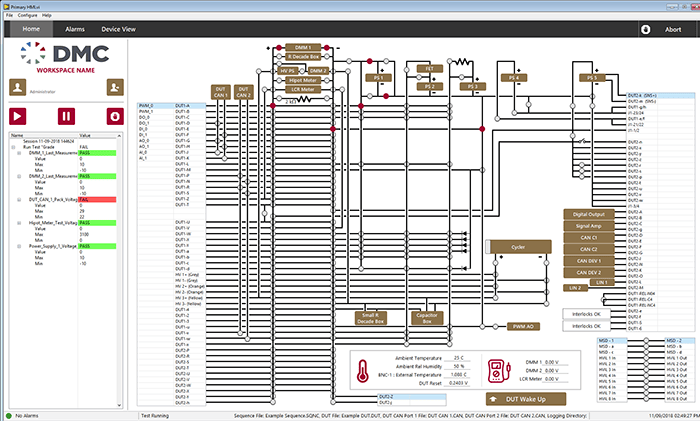DMC’s Flex Framework is built around the philosophy that many types of users will interact with the system and Device Under Test (DUT); be those technicians, operators, or engineers. Accordingly, the Flex Framework has two core modes of interacting with the system: manual mode and automatic mode.
These modes can be thought of as ‘states’ of the overarching application lifecycle.
Manual Mode
Manual mode provides a sandbox in which a test engineer can use the components of the system (such as power supplies, CAN ports, digital multimeters (DMM), etc.) to interact with the system or DUT. Manual mode is meant to have minimal checks and limitations; allowing engineers to perform advanced engineering diagnostics, probe or investigate a DUT, or simulate a to-be-programmed test sequence.
This application mode puts engineers in total control of the system and enables conduct the testing and measurements needed to verify and validate a DUT. Often the Grid Viewer is used to construct a testing interface while in Manual Mode, enabling engineers to control devices and see live data as a manual test is run.
Below is an example of a user using Manual Mode to toggle relays and pass a power supply output across a DMM.

Automatic Mode
Automatic mode allows operators and technicians to run a pre-programmed set of steps. These sequences are set up by an engineer and consist of building blocks which, when assembled, define the desired automated process or test.
While in automatic mode the operator can interact with the system through dialog prompts but otherwise isn’t able to manually toggle relays or activate devices.
Automatic mode’s routines can be set up using the Sequencer and often utilizes the Results Manager to display results to the operator, allowing for effective, automated End of Line (EOL) testing.
Why Multiple Modes?
The Flex Framework has these two automation modes to allow for users of varying access levels to interact with the system or DUT. Day-to-day operations of an EOL tester may not require the full diagnostic capability of Manual Mode. Instead, a pre-determined, automated sequence of steps need to be completed to properly test a product. A case such as this is perfect for Automatic mode, where the goal is to complete a pre-prescribed test and control how the user can interact with a system.
Conversely, a Research and Development engineer may be designing a test sequence and may require the full diagnostic capability of the test system. This is a perfect case for Manual Mode where the user would have complete control over the test instruments.
Allowing for multiple automation modes enables users to have the test system work as a deeply technical in-depth diagnostic tool when required or as a structured, controlled test executor with reporting capabilities all with no code changes by programmers!
These features are part of a powerful suite of tools called the DMC Flex Framework. Find out more about all of these tools here.
Learn more about DMC's LabVIEW programming expertise.